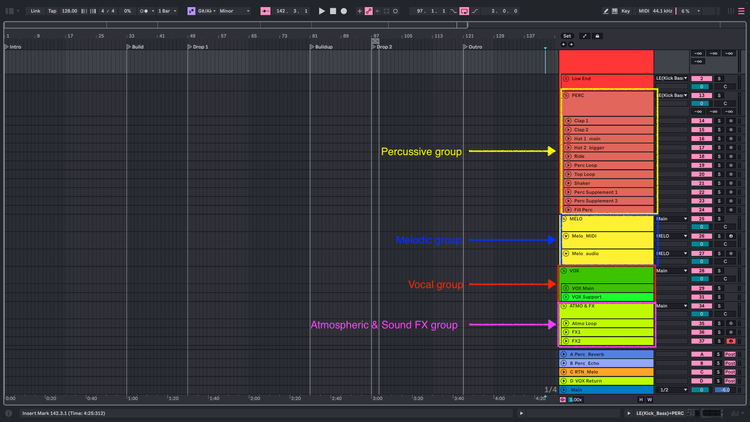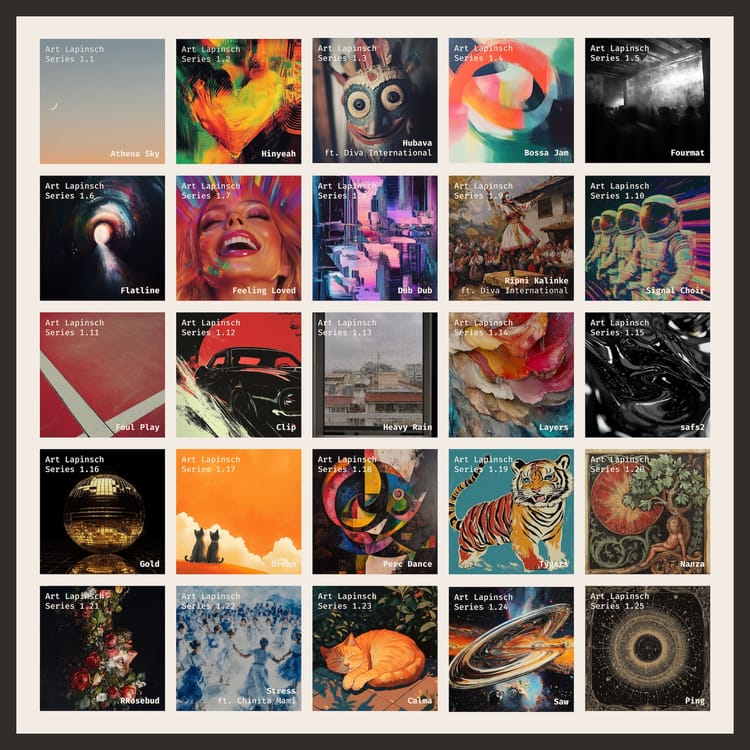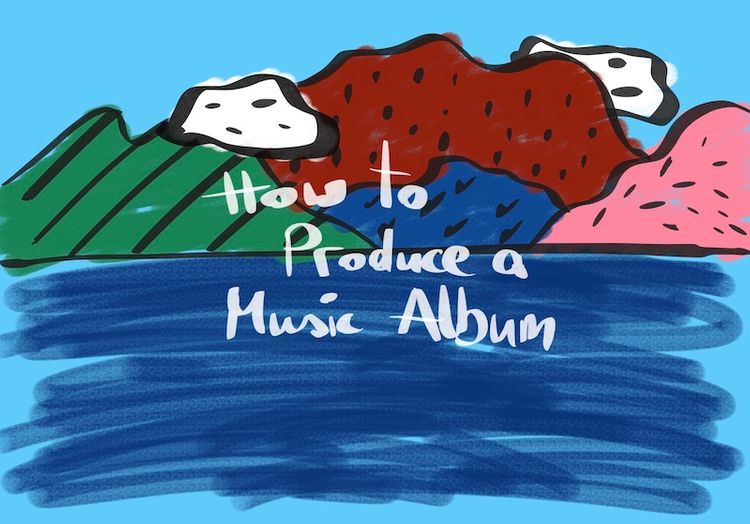Music Production Masterclass: Kilian Bohn

Update: The EP project I'm writing about in this post has been released on Spotify and Apple Music. Here's the full story.
During the covid lockdown in 2020 I picked up music production.
After a few remix projects a friend and I decided to collaborate on a documentary (subject: being stuck in Guatemala during the global lockdown).
- My Goal: Deliver a 4-track EP (movie soundtrack) before the end of the year
- Accountability: Be accountable to my collaborators (director + mastering engineer)
- Learning: Learn the entire process of album production (composition; instrumentation; arrangement; mixing; mastering; distribution)
This post is a summary of the collaboration and learning experience with Kilian - my mastering engineer.
Kilian: Working with a Full-Stack Music Producer
Kilian Bohn is a multiple award-winning sound engineer, music producer and lecturer.
Most importantly, he's a good friend.

- Taste: 10 hand-selected tracks by Kilian
- Expertise: Music Production; Engineering; Mixing; Mastering
The Collaboration: How to Work With a Mixing/Mastering Engineer
There's no one-size-fits all solution to music production and collaboration since different teams split the workloads differently (composition; instrumentation; arrangement; mixing; mastering).
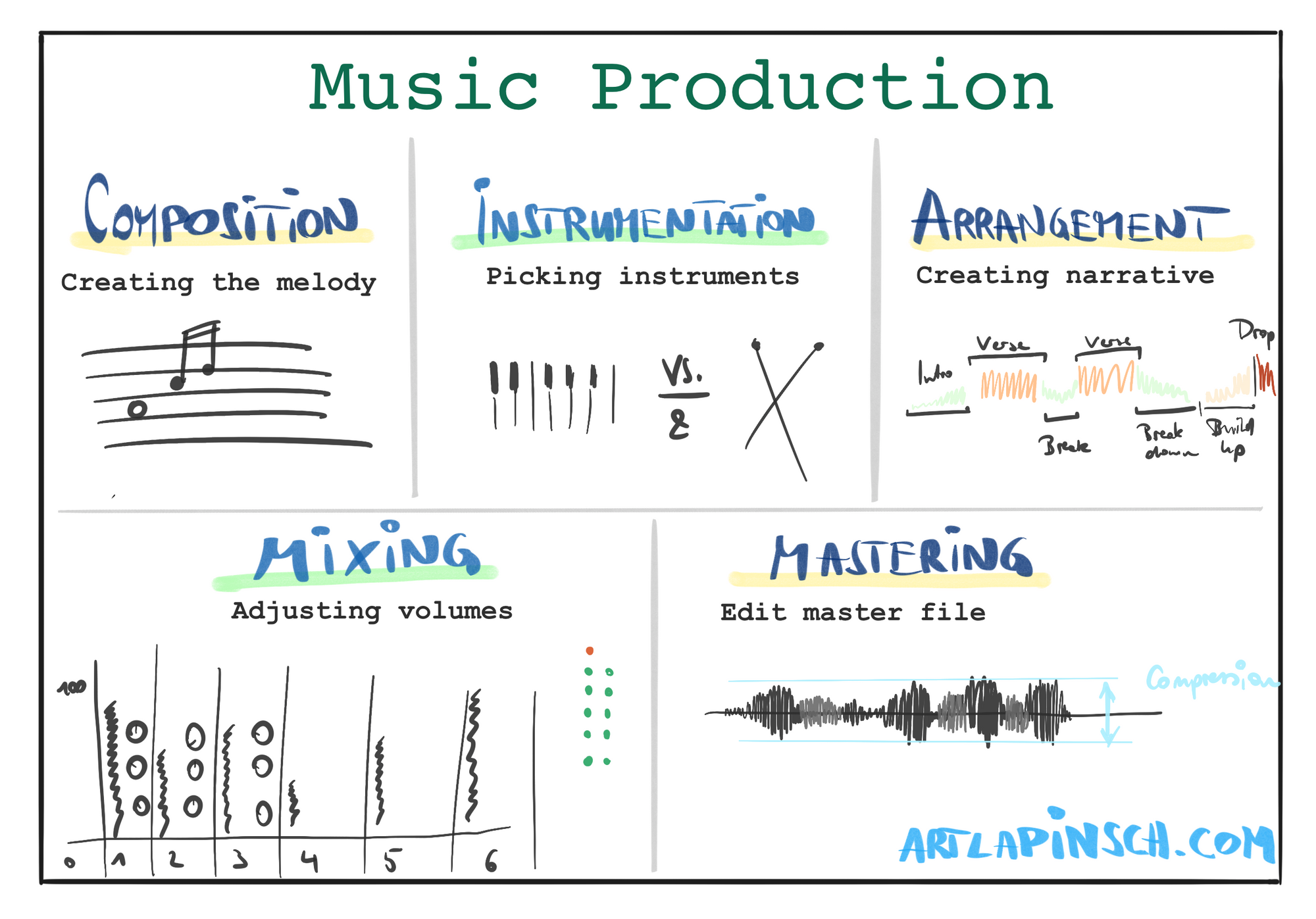
Our workflow looked like this:
- Kick-off Call: Artist and engineer discuss the scope (4 tracks) and idea (soundtrack with a cohesive story arc) of the project
- Track Draft: Artist sends track draft once they are at a first-presentable-draft stage (= arrangement is set; first version of mix complete)
- Feedback & Discussion: Engineer provides feedback and indicates if major fixes (e.g. instrumentation; arrangement; mix/levels; technical [file; etc.]) are needed before the master draft. Artists makes adjustments if needed.
- Master Draft: Engineer sends master draft
- Feedback & Discussion: Artist provides feedback and indicates if master is not fully aligned with artistic vision (e.g. general sound [too loud/silent; dynamic range]; sound at certain points; etc.)
- Rinse & Repeat: Artist and engineer work through track draft and master draft loops until both are happy
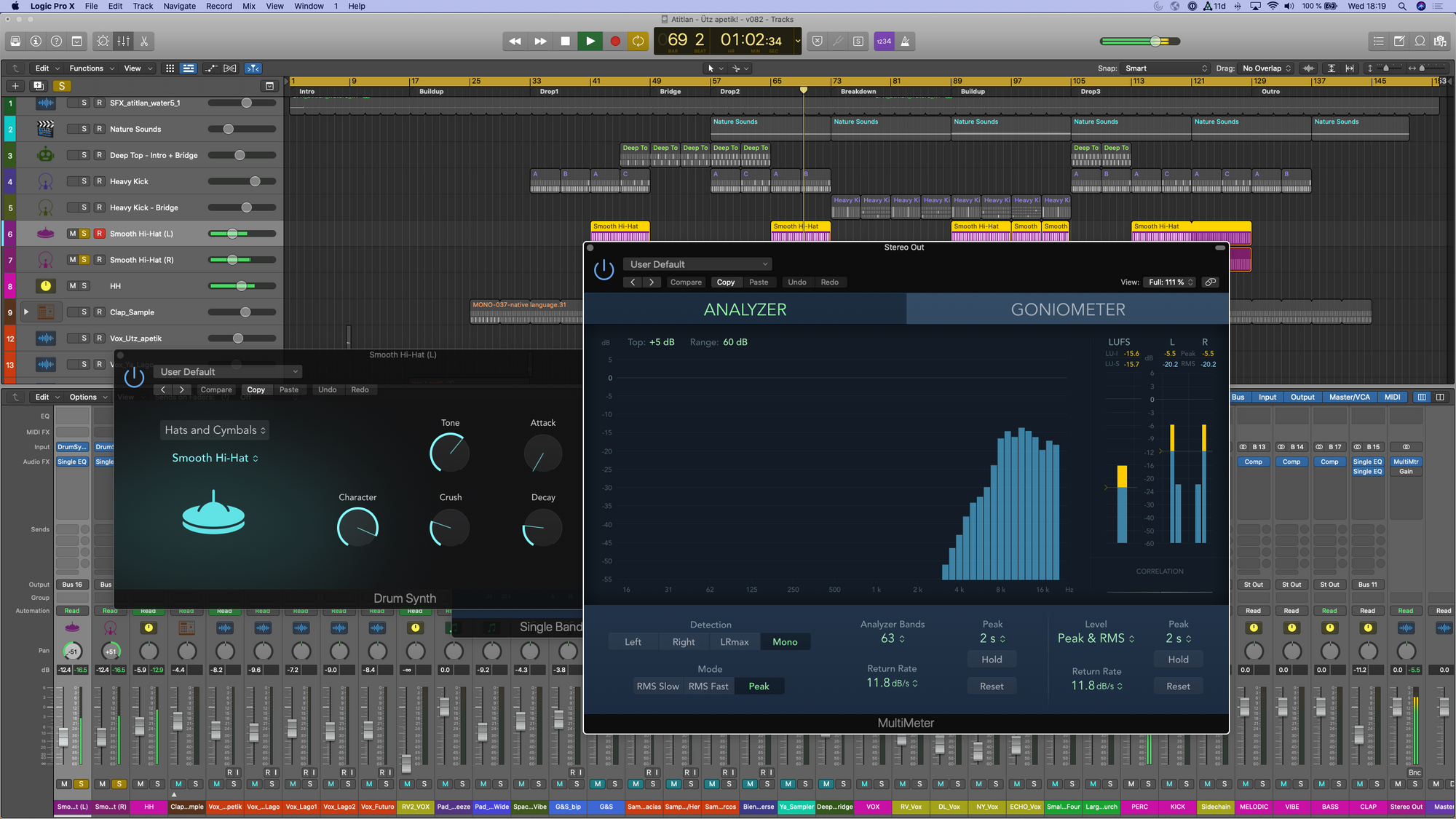

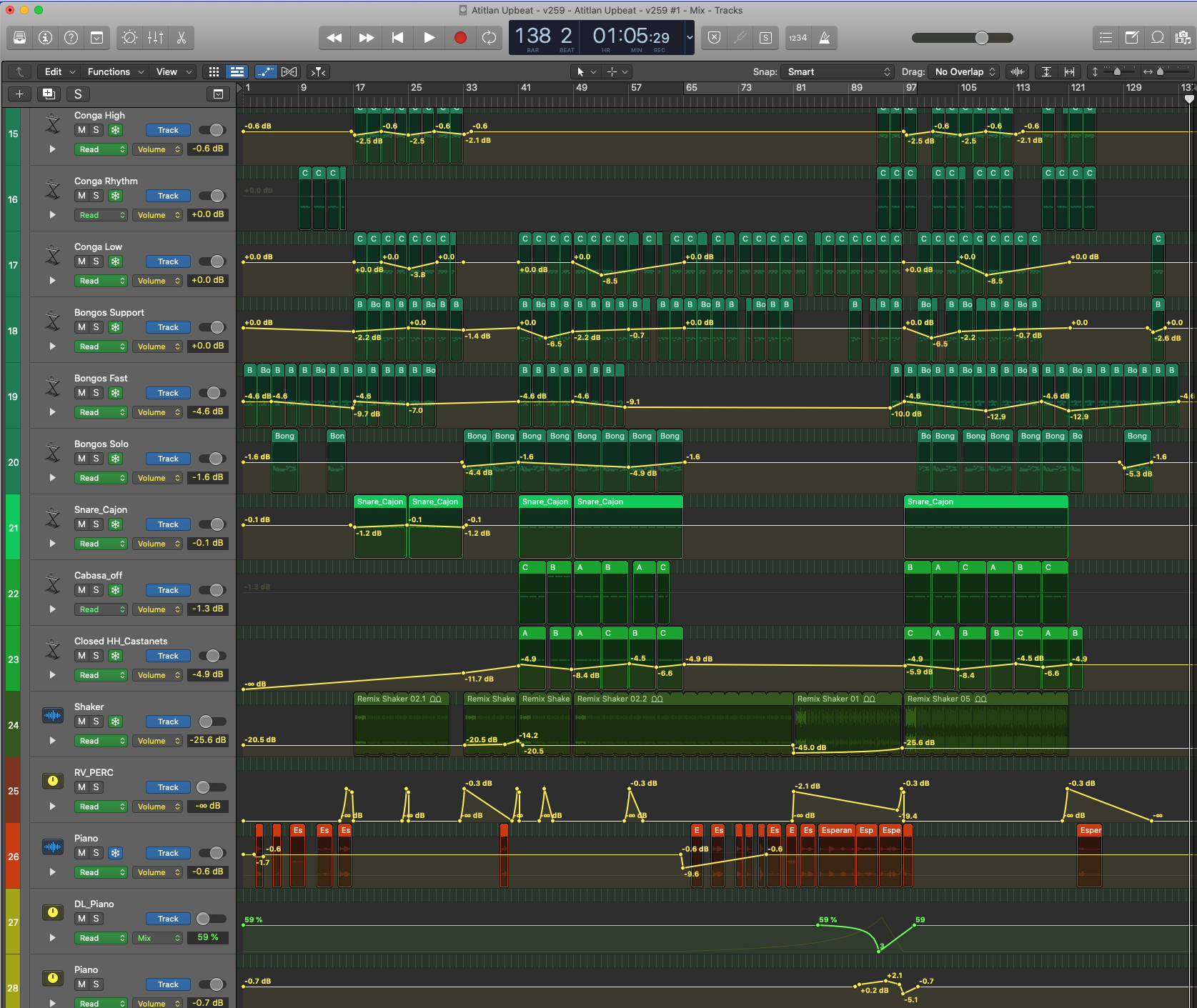
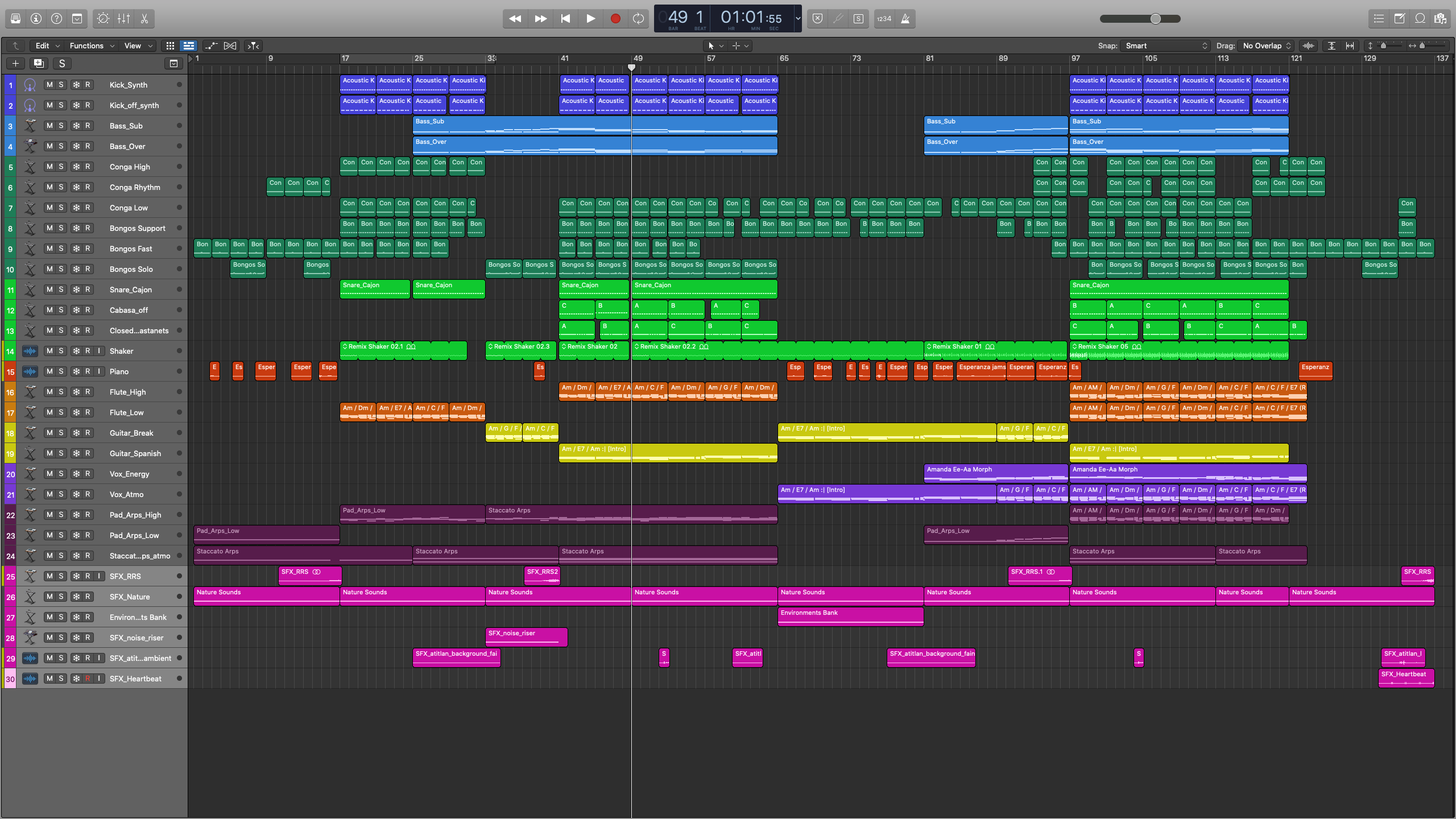
Tools & Rules: Making our Lives Easier
We mainly used the following tools:
- Logic Pro X: My DAW of choice
- Ableton Live: Kilian's workbench for mastering workflows
- Phone/Zoom: Quick discussion about drafts + next steps
- Email/Text: Written feedback on tracks
- WeTransfer/NextCloud: File sharing (wav audio files)
To keep our work efficient we followed a few simple rules:
- Files: Bounce/export tracks as wav files with 96kHz sample rate
- Naming: Each new update to the track gets a version number (e.g. [TRACK]_v001) and each bounce/export gets an additional collaboration number (e.g. [TRACK]_vo14 - bounce v001). This makes it easier to reference versions
Principles: Kilian's Guidelines for Successful Music Production
Applications are easy if you understand the principles.
#1 Identify the Main Elements of a Track
Our brains can process ~4 inputs/items at once. Not more.
https://www.ncbi.nlm.nih.gov/pmc/articles/PMC2864034/
Working memory storage capacity is important because cognitive tasks can be completed only with sufficient ability to hold information as it is processed. The ability to repeat information depends on task demands but can be distinguished from a more constant, underlying mechanism: a central memory store limited to 3 to 5 meaningful items in young adults.
For music production this means that you should have at max 4 main elements.
A typical combination could look like this:
- Rhythm: Kick + Percussion
- Lead: Vox/Synth/etc.
- Melody: Bass/Pads/etc.
Many times a track will have more elements, but the idea is to understand which sounds are the most important ones.
It's a good rule of thumb to think about relative importance of elements. Focus most of your time on them.
Important: This helps to avoid too many elements competing in similar frequency bands (example: vox; guitar; piano; synth in the same Hz range).
#2 "A Little Goes a Long Way"
Listen and trust your ears.
When making changes in the arrangement, mix, or master it is usually enough to make a small change.
One of the biggest mistakes people make is that they change too much and it tilts the balance of the entire track. Then you have to rework again. That's why 'a little goes a long way'.
#3 An Instrument Is a Combination of Many Sounds
Many people think that an instrument is only composed of a single sound, but that's an illusion. Think of a guitar, it is a combination of the following sounds: the pick hitting the string, the hand grabbing the frets, the vibration of the string, the vibration of the guitar's body, and so much more.
Once you understand the various frequency ranges at which each instrument works you can start to play with those to create the desired sound.
A great primer for this concept is the video below:
#4 "Something for the Hip and Something for the Head"
You can think about music in two basic layers:
- [Foundation] Something for the Hip: A groove and rhythm that makes you want to dance and shake your booty. Usually it is the kick drum, the percussive elements and the bass sounds.
- [Embellishment] Something for the Head: Melodic elements that make your head pay attention. Usually it is the vocals/vox, keys, string instruments, synthesizers, etc.
#5 Tension & Release
Tension and release is my favorite principle, since it has many applications beyond music:
- Professional/physical performance
- Physical exercise
- Negotiation
- Story telling
- ... the list goes on
For music you can think about tension and release in the following terms:
- Composition: Harmonic sequences that form a story (watch the video below for a good introduction👇)
- Instrumentation: Soft vs. harsh instrument; deep vs. high pitch; left vs. right (= panning)
- Arrangement: Verse/Chorus vs. Intro/Outro/Bridge/Breaks
- Mixing: Compression of sounds (release) based on trigger inputs (tension)
Techniques: Practical Insights for Music Production
A basic understanding of mixing is required to understand the content below.
#1 Mixing Sequence and Focus
Similar to the first principle (#1 Identify the Main Elements of the Track) you should focus most of your time mixing the main elements.
You would do that like so:
- Identify main elements
- Group similar elements (e.g. Kick + off-Kick) into Sub-/Mixing-Groups
- Start mixing (levels; compression; FX; etc.) those main elements and mute all other tracks
- Once main elements are mixed you unmute and mix the rest
Pro Tip: Start Mixing in Mono
#2 Pulling the Listener Into the Mix
Great tracks pull the listener into the music.
This is done via presentation of a noticeable element (example: lead synth) and a gradual reduction of volume of that element relative to the rest of the instruments. It's almost like pulling the listener's attention by its hand and 'dragging them into the mix'.
A great example of that technique is the following statement by producer Maya Jane Coles from her Resident Advisor interview:
I often layer multiple different sounds that cover four frequency ranges, especially with bass. There'll be a very filtered low, low sub below 100 Hz that sounds very muted, then the more solid, mono mid-range sound. If I'm creating a wobble bassline, then I'll make the cutoff frequency of the filter vary to create some movement. On top of that I'll have a more high-frequency, low-cut bass sound, and I'll filter that in and out throughout the whole track. I'll record the automation from start to finish so that there's never a static part and it's always changing a little bit.
That's especially important when the track revolves around a bassline, as with a lot of Nocturnal Sunshine stuff. I'll try and make sure that there's never eight bars where the bass is all flat and the movement is the same. Say automation is controlling the filter of one of the layered parts of the bass. Even if all the other three layered parts stay the same, it creates movement within that sound. A listener wouldn't necessarily know that that sound's created with three or four layers. It just gives it a slightly fuller sound with the movement.
#3 Mixing Depends on Context
The world is changing, and so are the expectations to what music should sound like.
(This is an entire rabbit hole in itself and I can recommend "How Music Works" by David Byrne [affiliate link] where he discusses this at length)
One of the first feedbacks I received from Kilian was the following:
Your tracks are very beautiful and nicely arranged. The one thing that I noticed was that the mix was very symphonic - meaning it had a very large dynamic range.
Usually this happens when people listen to a lot of organically produced music - like classic - and when they mix on headphones.
Both was true.
If the context of the music would be to have these tracks only as silent background for a movie it would work, but if you want the tracks to work in a club setting then we need to make some adjustments.
Modern music has an unnatural amount of sound pressure - particularly in the lower frequencies.
On top, there is a loudness war, every producer wants her tracks to be as loud as the references from beatport.
The reference tracks on beatport are compressed to death and therefore are consistently loud - on headphones and most importantly in the club.
Since my goal was to have tracks that could be played in a club/festival setting we needed to do some extra work.
#4 Sequential Sidechain Compression
Many producers use sidechain compression to give more space for their kick drum.
Example: Kick drum hits and triggers a sidechained compression of another element (in most cases a sub-bass or a synth).
But... it gets interesting once you start using sidechain compressions on multiple mix groups in similar frequency bands.
Let's assume you have vox, synth, and pads all occupying similar frequencies and you want to avoid a messy/muddy sound. To fix it you can apply sequential sidechain compression.
- Prioritize: Create an order of relative importance of your elements (1. vox // 2. synth // 3. pads)
- Group: Create 'cascading' mix groups (1. vox // 2. vox + synth // continue of there's more competing elements)
- Compress: Set up a sidechain compression in order of priority - each triggered by the preceding mix group (1. synth compressed by [vox trigger] // 2. pads compressed by [(vox + synth) group trigger])
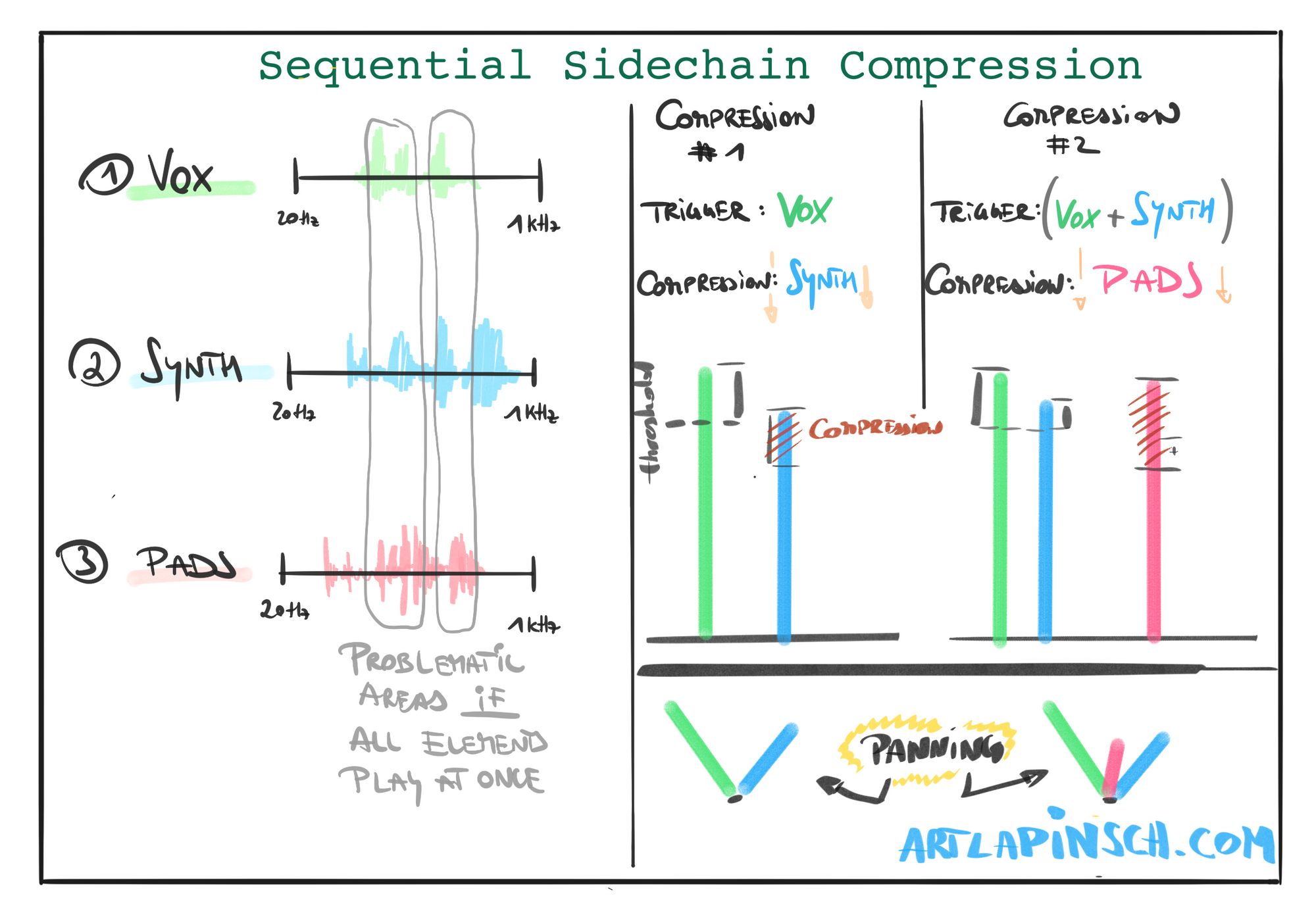
This takes some time to set up and dial in properly and would usually not be worth the effort. But, if you are at a point in your mix where certain sections just sound messy and you don't know how to fix it, this technique might be worth a shot.
Bonus: If it sounds good on mono with compression, wait until you hear it in stereo with proper panning.
Q&A with Kilian: Questions About Music
Questions inspired by expert interview guidelines from the book "4-Hour-Chef" by Tim Ferriss [affiliate link].
Translated from German.
#1: Who Is a Good Producer Against All Odds?
Can you think of anybody who is not musical at all, who is deaf, etc. ... who is not supposed to be good by normal standards. // What makes this person good?
First of all : Beethoven :) but also Rick Rubin or Chris Goss - both are great producers who consciously avoid the technical aspect of production and therefore can judge productions from a consumer's perspective.
Being deaf is a really bad prerequisite for making music as a producer or mixer, but imagination and willpower are more important.
#2: Who Is the Most Controversial Producer You Can Think Of?
What makes this person controversial? What do you think about the person?
Everybody can have a style that's different and interesting. I don't understand the "controversial".
For me, an approach to music has to be goal oriented for it to work.
#3: Who Are the Best Teachers/Experts That Are Lesser Known?
Why are they so good?
In general, stick to the nerds with good references (i.e. artists they have worked with) that are also successful themselves.
Mostly they are not afraid of competition and are very honest and generous with good knowledge.
#4: What Makes You Different from Other Musicians/Engineers?
Who did you learn from? Who were your biggest influences?
I am completely free of talent and have to learn everything the hard way.
I have a clear idea of what I want to hear and I have done all possible mistakes in the past :) This makes me pay attention to many details :)
I like to keep productions 'alive'. Ergo I like to do as little as possible in a production.
I don't know if this is different but I haven't read it anywhere yet.

#5: Have You Taught Your Methodology to Other People?
Could your students replicate your success and quality?
I hope :)
They are not students in the true sense of the word but rather colleagues. Together we examined their productions to discover new approaches for sonic improvements.
But I usually notice that their productions are getting better and better over time.
#6: What Are the Most Common Mistakes/Myths in Music Production?
What is totally overrated? Which mistakes are done by some professionals?
Became famous overnight
It must be louder
Equipment makes the production
There are so many:)
People waste a lot of time on loudness, compression, and high frequencies.
Professional are usually capable of remaining within the "auditory aesthetics" of their genre. Pros also have the right tools to cross-check their perception.
#7: What Is the Biggest Waste of Time?
What can be quietly reduced in your opinion?
The active working time :) Your hearing gets tired very quickly.
Trying to correct a frequency around 2kHz with a narrow band bell filter while the track is running and then immediately after moving on to balance the voice :) That's a nice way to waste time.
#8: What Are Your Favorite Resources on Music Production?
What do you find especially helpful/influencing?
Listening and not reading :)
I think that the Dikreiter / Blauert / everything about perception, acoustics and physics is more important than reading from others and just copy.
Bottomline, take inspiration and motivation wherever you find it.
#9: If Someone Wants to Learn Music Production Themselves, What Would You Recommend?
How should they proceed?
1. Ask yourself why you want to do that. And focus on the aspect that was your answer.
2. Listen to as much of the genre as you can, but also listen to a specific track and listen to it on as many audio systems (headphones; speakers; phone; etc.) as you can.
3. Do not stress, music production is a craft and an art with many aspects.
4. Look for a hobby like wood construction or anything else that gives you the opportunity to turn your ideas into reality. This makes you more aware of your blind spots.
Bottomline: Accelerated Learning with Kilian
Working with Kilian felt like an accelerated music production bootcamp. Also, we just finished the mastering process of the EP and it should be released soon.

I hope this writeup was helpful and you learned something now.
🤝 Resources
If you want to connect about music, please get in touch via soundcloud:
Here's the twitter summary thread:
“Without music, life would be a mistake” - F. Nietzsche
— Art Lapinsch 🤘 (@artlapinsch) October 3, 2020
This year, I picked up music production and I'll share my learnings below:
* Objectives
* Collaboration with Creatives and Engineers
* Principles of Music Production
* Helpful Techniques
👇

